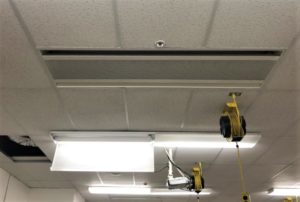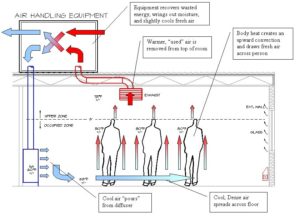Are you curious about the world of chilled beams? Do you want to know how they could impact your next project? We’ve got you covered! In our most recent How Great Buildings Work Podcast episode, JM Engineering’s founder, John Melvin, interviewed Titus HVAC’s Nick Searle. Nick is a Chief Engineer for Titus. During the show, Nick and John answered all of our chilled beam questions. Read our top three chilled beam questions below!
Where did Chilled Beams come from?
According to Nick Searle, chilled beams go all the way back to the mid to late eighties. Chilled beam systems originated in the Scandinavian countries. Europeans pay a lot more for energy than people do in the United States. There were some additional issues in some of the Scandinavian buildings with very low floor to ceiling heights, because the buildings were originally built without air conditioning. What happened in the mid-1980s was the advent of the personal computer terminal. Those terminals started appearing on everybody’s desk, and they were generating some internal heat. Before, there wasn’t much in the way of requirements for cooling, but now, suddenly, because heat was being generated within the space, there was a requirement for cooling. Basically, that drove the development of very compact, passive cooling systems such as radiant cooling, passive chilled beams, and then, later on, active chilled beams. These green technologies then moved their way west. They started off in Europe and moved over to the United Kingdom, which is still part of Europe of course, and then spread over into the United States in the mid-2000s.

Are there different types of Chilled Beams?
Yes! There are basically three different types of chilled beam. The first type, that was developed in the mid-eighties, was something called a passive chilled beam. A passive chilled beam, as its name implies, doesn’t have any fresh air delivery mechanism. It’s purely a passive device that is just hung from the slab using either drop rods or wires. It’s basically a coil in a box that chilled water is piped into, crucially above the room dew point condition, which is typically about a 58 to 60-degree chilled water temperature. How it works is: the Chilled beam just hangs in the space, and a convective current, caused by heat sources in the space, or the occupants, or solar load, causes some convective currents to rise. That air current comes in contact with the top of the coil inside the chilled beam, and the air cools off. Now, cooler air is denser than warm air, so it just falls into the space.
The second type of chilled beam is an active chilled beam. These units were developed a few years later, but are still a very simple device. It’s also essentially a coil in a box, but has what we call a primary air plenum chamber. There are a series of air nozzles connecting into this chamber. An air handler unit is used to force primary air through ductwork throughout the building that connects to the active chilled beam and drives induction through a series of nozzles. The nozzles are relatively high velocity and run about 3000 feet per minute, which causes room air to be induced, or essentially to be pulled from the room, then through the heat exchange coil where we can apply heating or cooling from hot water or chilled water. Then that air mixes with the primary air into the space.
The basic difference between the passive and the active chilled beam is that the passive is convective, which means you can’t heat with it, you can only do sensible cooling with it, and the active chilled beam is able to heat and cool. The active beam also carries your ventilation air to the space. To summarize those two types, both of them offer just sensible cooling. You don’t do any latent cooling with active or passive chilled beams. Humidity control is provided by the central air handling units, which sends air across the building.

The third type of chilled beam, which is less common, is called an induction displacement chilled beam. What it does is combine an active chilled beam, which of course has those induction nozzles mentioned earlier, with a different air delivery mechanism. It delivers the air at low velocity across the floor instead. This is called displacement ventilation. This type of ventilation has some comfort and air quality benefits over an active chilled beam, which delivers the air overhead. So, the main difference between the two is that an active chilled beam is mounted in the ceiling, and an induction displacement chilled beam is mounted on the floor.
How can Chilled Beams affect your bottom line?
Chilled beams allow for a more dynamic and efficient building design. Nick Seale explained this to JM Engineering’s, John Melvin. “I’ve got a very good recent example that I could discuss with you where the designers of the building did exactly that. Now, typically using an active chilled beam system compared to a traditional VAV system, the designers can expect to save around about 12 inches of floor space. In Europe, we found that in the major cities, high rise buildings can typically gain about a floor in height, by using a compact chilled beam system. So, there are more architects realizing this benefit in North America. One project that I recently got involved with is in Omaha, Nebraska, where there was an office building that was about seven floors. They compared a VAV system to chilled beams and they found that when they did the space calculations, they found that the VAV system required about overall 10% of the overall square footage of the building. When they looked at the chilled beam system, because of its compact size, so smaller air handling units, and as you mentioned John, the ductwork is smaller because you’re using pipework, they found that the chilled beam system only required about 4% of the overall space of the building.
The net result was that the seventh floor, if they were using a traditional air system like VAV, that whole seventh floor would have been a mechanical space. It would have been dedicated to the mechanical space. But with the chilled beam system, they designed the building slightly differently and they have smaller mechanical rooms on each floor, which meant that basically that whole seventh floor was now dedicated to office space. They also work back some calculations on cost and they found that in order to build an additional floor that they would have required had they gone with VAV, the building would have cost several million dollars more. Even when you take into account that a chilled beam system for an office building is generally a bit more expensive. There’s a premium you can expect between maybe 5% to 15%, depending on the building and its location, but over VAV there was a premium. But overall the building costs significantly less by using active chilled beams because they gained an extra floor.”
Are you still curious about chilled beams? Listen to the How Great Buildings Work podcast episode featuring Nick Searle to answer all of your chilled beam questions.
